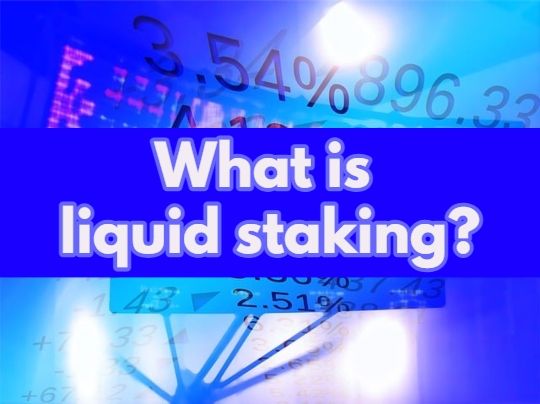What is liquid staking? What exactly are we talking about and what are the benefits? Introduction to liquid staking.
Liquid staking, To fully understand what we’re talking about, we need to go back to what staking is.
Quick description of staking: Staking refers to the process of participating in validating transactions and securing a blockchain network by locking up a certain amount of crypto-currency as collateral for receiving rewards.
Armand tells Nathalie about his latest discovery to earn passive income.
Armand: Hi Nathalie! You’ll never guess what I’ve just discovered recently. I’ve found a new way to earn passive income with my crypto-currencies!
Nathalie: Hi Armand! Really? How do you do that?
Armand: It’s all thanks to staking! Have you heard of it? It’s a process where I can lock my cryptos to help secure the network and earn rewards in return.
Nathalie: Oh yes, I’ve heard of it. You mean you leave your cryptos immobile for a certain period of time to earn more?
Armand: Exactly! But you know, there’s this new method called Liquid Staking. It gives flexibility to my staked funds. Rather than blocking them completely, I receive tokens representing my participation. These tokens can be exchanged or used on DeFi platforms while continuing to earn rewards.
Nathalie: Sounds interesting! But is it risky? I mean, aren’t you putting your funds at risk?
Armand: Well, as with any crypto-currency-related activity, there are always risks. But I choose reputable platforms and do thorough research before participating in Liquid Staking.The security and reliability of the projects are essential.
Nathalie: Hmm, I see. Does it take a lot of time or technical knowledge to get started?
Armand: Not really.The platforms are generally user-friendly and there are plenty of resources available to understand the ins and outs. You can even start with small amounts to test and see how it works.
Nathalie: Okay, that sounds really interesting!I’ll definitely take a closer look. Thanks for explaining all this to me, Armand.
Liquid staking, definition and introduction:
Liquid staking, is a mechanism that allows crypto-currency holders to participate in the staking process while maintaining the liquidity of their assets.
With traditional staking, holders must lock their funds into a specific smart contract or wallet for a given period in order to participate in the network consensus and earn rewards in the form of additional crypto-currency.
However, with Liquid Staking, holders can lock their assets while receiving tokens representing their participation (called « staked tokens » or « staking tokens »). These tokens can be used as collateral, or exchanged on decentralized platforms (DEX) for other assets, offering a form of liquidity to these staked assets.
Liquid staking therefore enables crypto-currency holders to benefit from staking rewards while maintaining flexibility to exchange or use their staked assets, rather than locking them up for a fixed period.
It should be noted that Liquid Staking mechanisms and platforms can vary depending on the blockchain projects and the specific protocols that support them.
How does it work in practice?
How Liquid Staking works can vary between protocols and platforms, but here’s a general overview of how it might work:
Depositing assets for staking: A crypto-currency holder decides to participate in staking by depositing his or her assets on a Liquid Staking platform. These assets are locked into a smart contract or specific mechanism for use in the transaction validation process.
Issuance of tokens representing participation: Once assets have been deposited, tokens representing the holder’s participation in staking are issued.
These tokens are « liquid » versions of the staked assets and are generally referred to as « staked tokens » or « staking tokens ». These tokens can be used as collateral or for transactions on decentralized platforms (DEX) or DeFi protocols.
Obtaining rewards: While the assets are being used for staking and the tokens representing this stake are being held, the holder can receive rewards in the form of additional tokens. These rewards are distributed according to the quantity of tokens staked and the specific rules of the blockchain network or protocol.
Flexibility to exchange or use staked tokens: Unlike traditional staking, where funds are generally blocked for a fixed period, staked tokens in Liquid Staking can often be exchanged or used for other financial activities. For example, these tokens can be exchanged for other crypto-currencies, used as collateral to borrow funds, or participate in other DeFi protocols for additional returns.
Withdrawal and destakage: At some point, the holder may decide to withdraw their staked assets. This may require a de-stakage process where the staked tokens are exchanged for the original assets, and after a specific delay period, the assets are made available for withdrawal.


Un commentaire sur « What is liquid staking? »
Les commentaires sont fermés.